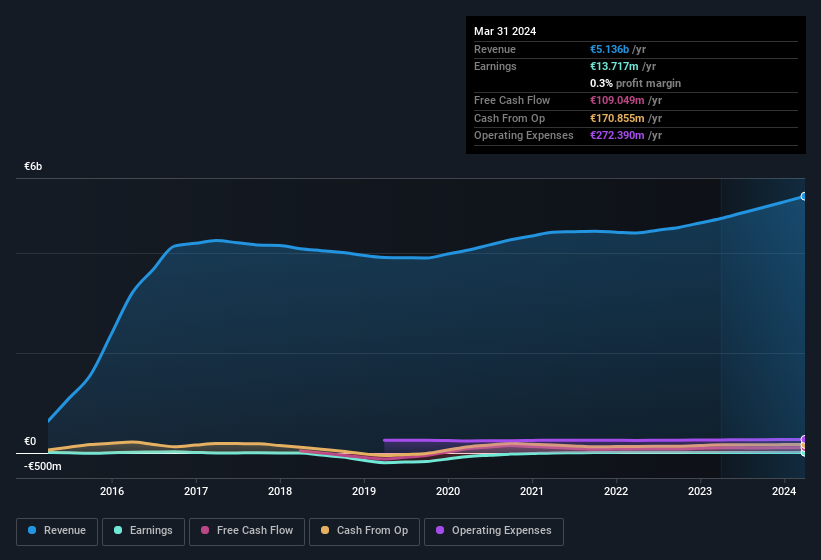Statutory Profit Doesn't Reflect How Good Greenyard's (EBR:GREEN) Earnings Are
Greenyard NV's (EBR:GREEN) strong earnings report was rewarded with a positive stock price move. We did some digging and found some further encouraging factors that investors will like.
View our latest analysis for Greenyard

Examining Cashflow Against Greenyard's Earnings
One key financial ratio used to measure how well a company converts its profit to free cash flow (FCF) is the accrual ratio. The accrual ratio subtracts the FCF from the profit for a given period, and divides the result by the average operating assets of the company over that time. This ratio tells us how much of a company's profit is not backed by free cashflow.
That means a negative accrual ratio is a good thing, because it shows that the company is bringing in more free cash flow than its profit would suggest. While it's not a problem to have a positive accrual ratio, indicating a certain level of non-cash profits, a high accrual ratio is arguably a bad thing, because it indicates paper profits are not matched by cash flow. To quote a 2014 paper by Lewellen and Resutek, "firms with higher accruals tend to be less profitable in the future".
Over the twelve months to March 2024, Greenyard recorded an accrual ratio of -0.14. Therefore, its statutory earnings were quite a lot less than its free cashflow. To wit, it produced free cash flow of €109m during the period, dwarfing its reported profit of €13.7m. Greenyard's year-on-year free cash flow was as flat as two-day-old fizzy drink.
That might leave you wondering what analysts are forecasting in terms of future profitability. Luckily, you can click here to see an interactive graph depicting future profitability, based on their estimates.
Our Take On Greenyard's Profit Performance
As we discussed above, Greenyard has perfectly satisfactory free cash flow relative to profit. Because of this, we think Greenyard's earnings potential is at least as good as it seems, and maybe even better! Unfortunately, though, its earnings per share actually fell back over the last year. The goal of this article has been to assess how well we can rely on the statutory earnings to reflect the company's potential, but there is plenty more to consider. Keep in mind, when it comes to analysing a stock it's worth noting the risks involved. For instance, we've identified 2 warning signs for Greenyard (1 is potentially serious) you should be familiar with.
This note has only looked at a single factor that sheds light on the nature of Greenyard's profit. But there is always more to discover if you are capable of focussing your mind on minutiae. Some people consider a high return on equity to be a good sign of a quality business. So you may wish to see this free collection of companies boasting high return on equity, or this list of stocks with high insider ownership.
New: Manage All Your Stock Portfolios in One Place
We've created the ultimate portfolio companion for stock investors, and it's free.
• Connect an unlimited number of Portfolios and see your total in one currency
• Be alerted to new Warning Signs or Risks via email or mobile
• Track the Fair Value of your stocks
Have feedback on this article? Concerned about the content? Get in touch with us directly. Alternatively, email editorial-team (at) simplywallst.com.
This article by Simply Wall St is general in nature. We provide commentary based on historical data and analyst forecasts only using an unbiased methodology and our articles are not intended to be financial advice. It does not constitute a recommendation to buy or sell any stock, and does not take account of your objectives, or your financial situation. We aim to bring you long-term focused analysis driven by fundamental data. Note that our analysis may not factor in the latest price-sensitive company announcements or qualitative material. Simply Wall St has no position in any stocks mentioned.
About ENXTBR:GREEN
Greenyard
Supplies fresh, frozen, prepared fruits and vegetables, flowers, and plants in Germany, the Netherlands, Belgium, the United Kingdom, France, rest of Europe, and internationally.
Undervalued with excellent balance sheet.
Similar Companies
Market Insights
Community Narratives



